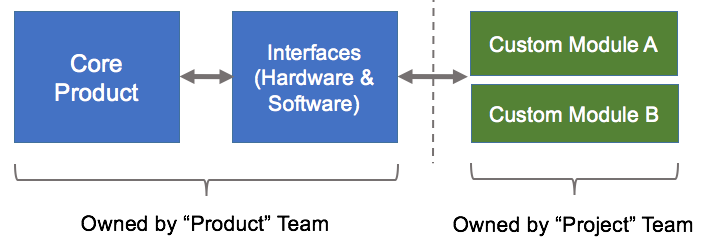How to Avoid the Trap of Building One-Off Features for IIoT Products
IIoT customers often demand a fully functional, end-to-end solution. And, most products often fall short of “the last mile” to give these customers exactly what they need. To bridge this gap (i.e., close the deal, or satisfy an important customer) Product Teams often agree to develop one-off features for that particular customer.
Overall, the Product Team has the right intentions, since their goal is to make the customer successful. But in practice, they are digging themselves into a sea of tech debt and one-off features that will hinder growth and threaten the long-term success of the product.
Creating customized versions of your product eats away at your profit margins because your company is not able to amortize the cost of one-off development across multiple customers. Quoting Rich Mironov’s second law of software economics, “All the profits are in the nth copy or nth user.” And if I extend his definition to IIoT we can say: “All the profits are in the nth IIoT system (software and hardware).”
Although we all can relate to Rich’s law of software economics, in practice, it is tough to arrive at this model when selling to industrial customers. The reality is that industrial customers require a certain level of customization to fit their exact needs or to integrate your product with their existing systems.
How can you prevent falling into the “one-off development trap?” How can you meet your customer’s needs for a turn-key solution without outsourcing your roadmap to your customers? And even better, how can you leverage customization to open new potential sources of revenue or to differentiate your product further?
The key lies in your IIoT product strategy.
Make Product Customization a Part of Your IIoT Product Strategy
If you are continually seeing the need to develop one-off features, then you (and your team) need to decide how to approach this in a way that is sustainable and provides new profitable opportunities for your company.
I recommend working with your teams to decide early on how much customization (if any) your core product allows. This decision will become a pillar of your IoT product strategy, so make sure you spend the time evaluating the implications of developing a customizable product.
The decision to build a customizable product will have a significant impact not only on your product roadmap and product team, but also in many other areas of your company.
For example, if you decide to implement a customizable product, then:
- Your company will need a strategy to monetize custom solutions.
- The Product team will need to research new persona types (integrators and developers).
- Engineering (software and hardware) will need to re-architect your product to enable customization.
- Marketing will need to develop new product positioning.
- Sales will need people capable of selling customizable solutions, and they will require additional training to understand what they are selling.
- Business Development will need a new partner strategy.
- Customer Success and Support teams will need to figure out how to support your customers when they have a customized solution.
On the other hand, deciding not to provide a customizable product also has significant implications for your product strategy. In this case, you’ll need a clear messaging on how your product differentiates from competitors that enable customization, and you’ll need to be very diligent in turning down all opportunities to create custom or one-off features.
What Does a Customizable Product Look Like?
There is no one-size fits all approach for how much customization your product enables. You need to make that decision as part of your IIoT product strategy. On one end of the spectrum, you can allow minimum customization on top of your product, and on the other end, you can offer your product as a platform for others to develop their full solution.
When building a customizable product, the first step is to define a clear separation between your core product, the interfaces you expose, and the one-off customizations.

The core part of your product, including the interfaces, belongs to the Product Team. This is the portion of the product that every single customer gets. It has a clear roadmap, lifecycle, and your team maintains it on a specific schedule.
The right side of the diagram shows the modules that are specific to each customer. Each block represents a unique development effort to meet the particular needs of a single company. Companies usually manage this development as a “project” as opposed to a “product.”
To implement this approach, you need to have a clear plan for the division of “product” vs. “project.” The product and project aspects of your offering usually have separate development teams, timelines, and business goals.
In fact, part of your IIoT product strategy is to determine if the “project” team will be part of your company, in the form of an internal Professional Services organization, or if it is better to outsource that component and engage third-party integration firms to develop custom components.
Where Can You Enable Customization?
As part of your IIoT product strategy, you can decide to open your product up for customizations at any layer of the IoT Technology Stack.

Once you identify the different areas where you’d like to enable customizations, I recommend reviewing the IoT Decision Framework to see how your decisions impact all areas of your product, including user experience, monetization approach, cost structure, security implications, the impact of regulations, etc.
The key to a successful customizable product is having clearly defined interfaces between your core product and the one-off customizations. I use the word “interface” as the generic term for both hardware and software interfaces. For hardware, I’m referring to specific connectors in your PCB that allows third-parties to enhance your hardware offering. For software, I’m talking about Application Programming Interfaces (APIs) that you can expose with the desired functionality.
Here are some examples of customization areas you can offer throughout the IoT Technology Stack. Remember you don’t have to provide customization areas at all these layers. You can pick and choose the ones that make sense for your product and business model.
The Bottom Line
Many teams fall into the trap of adding customer-specific features into their product. Now you know how to avoid the trap, so don’t let this happen to your team.
Taking the time to define your IIoT product strategy will give you a clear understanding of how your product can win in the market. That strategy needs to account for how your Industrial IoT product will manage customization requests.
Overall, developing a customizable product is not cheap or easy, but in the long-run, it will save you and your team a lot of headaches, it will open opportunities for new business, and it might be able to secure you as the winning product in your industry.
Read the full article on Daniel Elizalde’s blog.
 This article was written by Daniel Elizalde, an Internet of Things (IoT) expert with over 17 years of experience as a product leader, consultant, and software engineer. He is an IoT Product Management Coach and Advisor, and the creator of the IoT Decision Framework, a comprehensive method for IoT product management & strategy. Daniel’s diverse background includes working at Fortune 500 companies and growth-stage start-ups, as well as product companies and services companies. He teaches IoT Product Management Online and at Stanford Continuing Studies.
This article was written by Daniel Elizalde, an Internet of Things (IoT) expert with over 17 years of experience as a product leader, consultant, and software engineer. He is an IoT Product Management Coach and Advisor, and the creator of the IoT Decision Framework, a comprehensive method for IoT product management & strategy. Daniel’s diverse background includes working at Fortune 500 companies and growth-stage start-ups, as well as product companies and services companies. He teaches IoT Product Management Online and at Stanford Continuing Studies.
Sorry, the comment form is closed at this time.




Pingback: RT IIoT_World: A new great article by Daniel Elizalde – How to Avoid the Trap of Building One-Off Features for #IIoT Products. http://iiot-world.com/connected-industry/how-to-avoid-the-trap-of-building-one-off-features-for-iiot-products/ … #produ